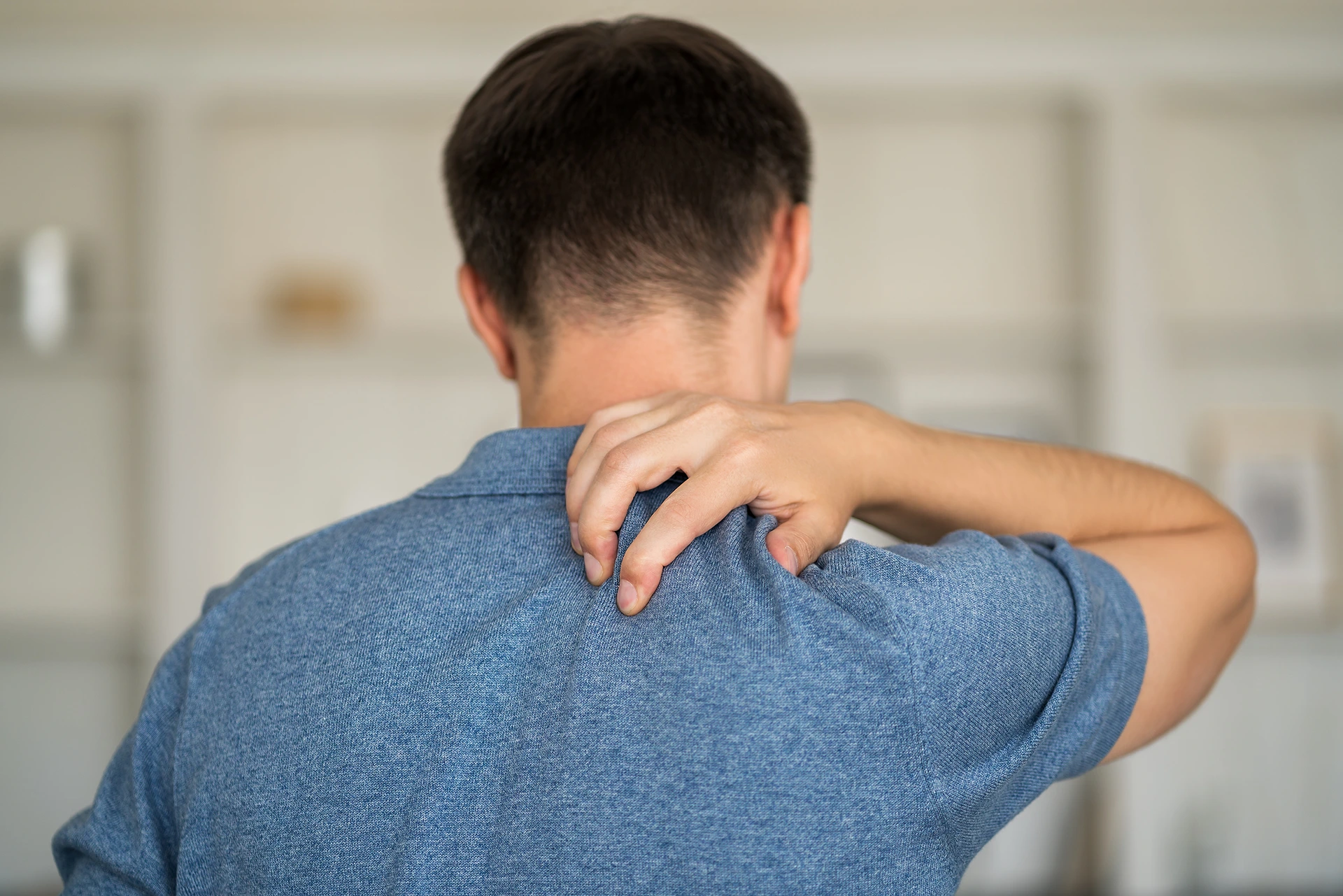The Pain Between Your Shoulder Blades May Be More Than Just Poor Posture
You’re probably one of the millions experiencing upper back pain right now.
But did you know that your nagging soreness may be more than just poor posture or too much time hunched over a laptop? Emerging research shows that upper back pain can be a surprising symptom of COVID-19.
While most people are familiar with the hallmark COVID symptoms like fever, cough, and shortness of breath, the diverse ways the virus impacts the body are still being uncovered.
Recently, there have been increasing anecdotal reports of COVID-positive patients complaining of pronounced upper back pain and discomfort. The question remains – is there a legitimate connection? Or is this another case of the virus triggering diffuse aches and pains already endemic to the human condition?
In this blog post, we’ll explore what the science says so far about the relationship between COVID-19 and upper back pain.
You’ll learn how to identify if your symptoms may be linked to the virus, what possible mechanisms could cause this pain, and most importantly, how to find relief from lingering soreness.
What Are The Common Symptoms of COVID-19?
Since coronavirus first emerged, health experts have been compiling the most frequently seen symptoms. The core set of classic COVID-19 indicators includes:
- Fever
- Cough
- Shortness of breath
- Fatigue
- Sore throat
- Congestion or runny nose
- Headache
- Muscle/joint pains
- Chills
- Loss of taste or smell
This combination of respiratory and flu-like complaints accounts for the majority of COVID cases. However, throughout the pandemic, it’s become clear that infection can also manifest in many atypical ways.
Patients began reporting a surprisingly diverse array of symptoms affecting multiple systems beyond the lungs. These include nausea, vomiting, diarrhea, skin rashes, mood changes, and more. The virus appeared capable of creating a mosaic of symptoms varying greatly between individuals.
Among these expanded symptom lists came mentions of pronounced back pain by a subset of patients. Often concentrated in the upper back between the shoulder blades, this pain was sometimes even their most prominent discomfort.
Could Upper Back Pain Be a Symptom of COVID-19?
With back pain being so common already, is this just coincidental or a meaningful occurrence?
Unfortunately, the current research remains limited and contradictory. Isolating COVID as the definitive cause of vague symptoms like back pain is extremely challenging.
Small observational studies to date have found a percentage of hospitalized COVID patients do report upper back pain, though numbers vary. However, correlation does not always imply causation.
Experts say larger controlled studies are needed to truly confirm if this symptom is directly linked to the coronavirus or simply coincidental. However, pain between the shoulder blades is one of the top listed musculoskeletal complaints in patient surveys.
There does appear to be possible evidence of a connection. But more research is required to fully substantiate it as an official COVID symptom.
What Does Upper Back Pain From COVID-19 Feel Like?
Based on patient reports, upper back pain related to COVID has been described in many ways, including:
- Tightness
- Soreness
- Burning sensation
- Aching
- Tenderness
- Stabbing discomfort
The pain intensity covers a wide spectrum as well, ranging from mild muscle soreness to completely debilitating back spasms. It may feel muscular in nature or more centered on the spine and shoulder blades.
Some cases are acute and temporary, while others develop into chronic back pain lasting months.
The discomfort may be localized or radiate across the upper back area. Essentially, this manifestation can resemble typical back pain from other causes like poor posture, strained muscles, arthritis, etc.
There does not appear to be any one universal pain signature. However, a post-viral inflammatory response resulting from the virus does offer one plausible explanation.
Why Might COVID-19 Cause Upper Back Pain?

While research has not yet confirmed a solid link between COVID-19 and upper back pain, scientists have theorized possible reasons for this connection if it exists.
Inflammation
One leading theory is that the viral infection triggers widespread inflammation. This can irritate nerves and pain receptors in the upper back and surrounding musculoskeletal tissue. Those with pre-existing upper back problems may be more susceptible.
Lung Irritation
The lungs sit near the upper spine, so severe COVID-related lung inflammation could potentially radiate outward and cause upper back discomfort.
Coughing
Frequent coughing fits from the virus may strain intercostal muscles between the ribs attaching to the upper spine region.
Posture Change
COVID breathing difficulty can hunch the upper back, causing compensatory muscle spasms and pain.
Stress and Anxiety
Mental health distress from COVID has also been linked to neck and back tightness through increased muscle tension.
Researchers are still working to confirm if COVID-19 can directly precipitate upper back pain or simply exacerbate an existing condition like arthritis or poor posture. But many experts do believe a connection seems plausible anatomically.
Dealing With Upper Back Pain Related to COVID-19
If you develop upper back pain either during or following a known COVID infection, how do you find relief? Should this symptom be addressed any differently than run-of-the-mill back pain?
Overall, the same practices for treating general back discomfort typically apply. Below is a table of some common treatments:
| Treatment | Description |
| Rest | Avoid strenuous activity that aggravates pain. Modify movements and posture that cause flare ups. |
| Heat/Ice | Alternate hot packs or heating pads and cold compresses for pain relief. |
| OTC Medication | Anti-inflammatories like NSAIDs (ibuprofen, naproxen) or acetaminophen can ease soreness. |
| Stretching/Massage | Gentle shoulder and upper back stretches and massage can provide myofascial release. |
| Posture | Be mindful of posture during illness. Avoid hunching over or slumping. |
| Support | Use pillows, braces, or KT taping to improve spine alignment and stability. |
| Stress Relief | Try relaxing exercises, deep breathing, and other stress management techniques. |
The key is tailoring these remedies to your specific pain severity and symptoms. Those with mild upper back discomfort may find relief through gentle stretching, OTC medication, and hot/cold therapy.
Your doctor can rule out other concerning causes like lung or heart issues presenting as upper back pain. Reporting your full history of COVID-19 infection and timeline of symptoms will also be important.
From there, your physician can create a customized treatment plan which may incorporate:
- Medication adjustments
- Physical therapy referral
- Imaging tests if needed
- Pain management options
- Postural correction
- Lifestyle changes
- Mental health support
Though inconclusive so far, the possible link to COVID-19 is important for both patients and providers to be aware of. Discussing your recent health history can aid in faster diagnosis and more targeted treatment.
Preventing Future COVID-Related Back Pain
Can you take any proactive measures to potentially avoid upper back issues if infected with coronavirus in the future? While not guaranteed, some best practices include:
- Maintain healthy spine alignment through regular exercise. Strong back muscles better withstand respiratory illness complications.
- Address any underlying back problems now before viral exacerbation worsens them. Physical therapy can improve joint mobility and muscle flexibility.
- Manage mental health proactively as well. Less stress and anxiety may minimize chances of stress-induced neck/back tightness during illness.
- Learn gentle stretching and postural correction exercises to use if infected. Proper movement can calm muscle spasms and nerve irritation.
- Have OTC medications, heating pads, ice packs, and other relief supplies ready in your medicine cabinet to start using immediately.
Though a largely neglected complaint initially, upper back pain may be a more significant yet overlooked symptom of COVID-19. As both our scientific knowledge and this coronavirus itself continue evolving, staying vigilant about new developments is key.
Finding the Right Care for Your Back Pain

Upper back pain can stem from myriad causes, ranging from simple muscular strain to more complex conditions like arthritis or even COVID-19.
The problem for many is identifying the precise source of their discomfort amidst all these possibilities. But specialized care from a provider well-versed in treating upper back issues can make all the difference.
The most effective path to relief starts with selecting a practitioner equipped with the proper diagnostics, experience, and treatment modalities for your unique pain.
On platforms like Kaly, patients can easily research doctors based on specialties, specific skills, real patient reviews, and direct appointment booking. By answering a few quick questions about your back pain history and needs, Kaly can instantly match you to providers positioned to deliver superior care.
Rather than resorting to guesswork in choosing a doctor, leverage technology and data to find your optimal back pain specialist. Regain comfort and mobility faster through precisely personalized care.
